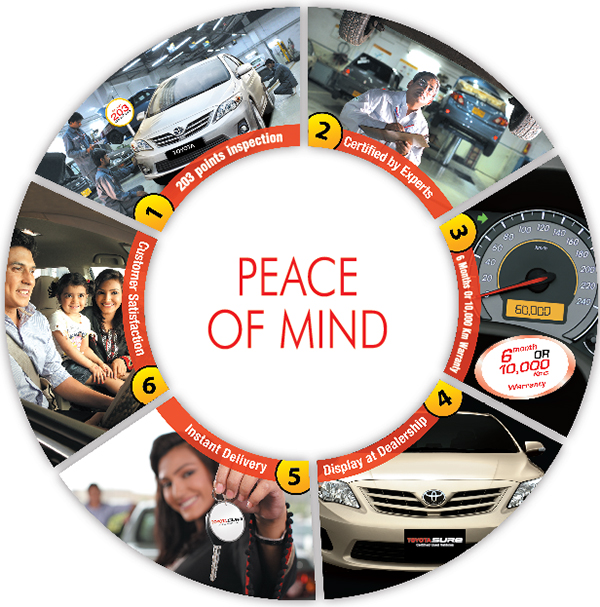At every used car has different aspects, each cars is checked on 203 check points to ensure the high quality and provide through evaluation.
Quality Used Car Certified

filter_1
ToyotaVehicleInspection
filter_2
CERTIFIEDbyExperts
After the detailed inspection on Toyota Vehicle Inspection System, only the best Toyota Cars are selected to be refurbished and certified by Experts on Toyota Global Standards.
filter_3
6 MONTHS10,000
KILOMETERS
All Toyota Certified Used Vehicles are inspected and refurbished with Toyota Genuine Parts and come with a warranty of 6 months/10,000 Kms* to provide the customer unlimited peace of mind.
filter_4
DISPLAYat dealership
After the car is refurbished and certified by experts with warranty, the car is displayed at dealership for retail.
filter_5
InstantDELIVERY
The car is delivered instantly without any hassles to the customer.
filter_6
CUSTOMERsatisfaction
All this Process results in the peace of mind for the customer and provides him ultimate satisfaction which frees him of all worries of buying a used car.
| Toyota SURE Promise | Authorized Dealer | Private Seller |
|---|---|---|
| Only the best vehicles are eligible for certification | ||
| Most of our certified vehicles will have a full service history | ||
| It includes a 6 months or 10,000 km extended warranty with nationwide coverage | ||
| It will be reconditioned with Toyota’s global standards | ||
| It will be confirmed to have no major accidents, engine or transmission failure | ||
| It will carry all authenticated, verified documents with seller credentials | ||
| Get the best price for your used car | ||
| You will be enrolled to Toyota SURE club and get after-sales benefits |
Guide for buyer and seller
Guide
- Buyer's Guide
- Seller's Guide
- Look for signs of accident damage or rust, such as red or other dark color stains. Bubbling or dimpled paint can also indicate rust.
- Check the horizontal surfaces such as the roof, bonnet and boot for signs of hail damage.
- Look for a consistent paint finish. If the color is not the same all over the car, it may be a sign of extensive damage and a re-spray.
- Use a magnet to detect rust and repair work. If the magnet does not stick to any point on the car's surface; it may have been repaired with plastic, fiberglass or another non-metal material.
- The door and boot should close smoothly and firmly. Also examine the rubber seals for signs of paint, which could point to a re-spray.


- Inspect for oil, water or other fluid leaks around the engine and under the car.
- Check the level and color of the engine oil. It should be golden in color and free of debris. Dirty oil or a low level can indicate poor maintenance.
- Look for signs of rust or damage on the battery terminals and connectors.
- Start the engine and ensure there are no unusual rattling or knocking noises, even when cold. The oil light should go out soon after the engine starts.
- Check the odometer; if the numbers are out of line, it may have been tampered with. The figure should be consistent with the advert and registration documents.
- Test the windscreen wipers and make sure the wiper fluid is dispensed properly.
- Check all headlights, high beams and brake lights are working.
- Look for signs of wear and tear on the seat belts and carpet.
- Ensure safety features such as airbags and the spare tire are up to scratch.
- Ensure all internal features – including the air conditioning, electric windows, sunroof and seat belts – are in working order.


- Start the engine and check the color of the exhaust fumes. Blue smoke indicates the engine is burning oil, while black shows excessive fuel consumption.
- When turning on the car, check whether the engine starts smoothly. If it doesn’t then the vehicle might need a new battery.
- Take the car for a test drive on different surfaces. Keep an eye on temperature changes which could indicate overheating.
- If buying a manual transmission, ensure the clutch operates smoothly and all gears engage easily.
- Check the brakes are effective. The car should not pull to one side when braking and the brake pedal should not feel too soft.
- Test the steering alignment during the drive. Do this by taking your hands off the steering wheel and see if the car drifts to either side. If that is the case, then consider asking the owner to fix it.
- Check the sealant application for accident checks.
- Check engine oil, brake oil level and engine oil condition (Color, thickness).
- Leakage and damages to be checked visually.
- Check the battery condition (Age, Charging and splash etc.)
- Check engine and chassis numbers of ID Plates.


- Check the registration copy of the vehicle physically and make sure that it has not been tampered or changed in any way.
- Ask for return file, either it is with the owner or in the excise office. If the owner has it, check it carefully. Check if it is a duplicate.
- Match registration number, engine number and chassis number on documents and on parts of the vehicle.
- Ask for original computerized number plates which come with vehicles registered within the past few years.
- Check original CNIC of the owner and match it with the owners name written on the registration book.
- You can instantly check CNIC details of anybody from NADRA by sending its 13 digits number to 7000.







